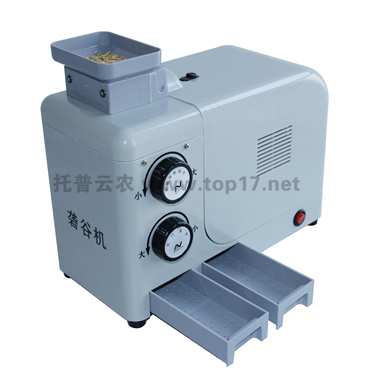Introduction to the working principle of the experiment
Shibuya is actually shelling, which refers to the process of removing rice husks during rice processing, and the machinery used for rice shelling is called the glutinous rice machine. In the rice inspection, the relevant tests are often carried out, and often no such samples are needed. At the same time, in order to improve the accuracy of the test, the requirements for sample processing are relatively high. Therefore, in the experiment, the large-scale glutinous rice machine used in rice processing is not used. Instead, it uses a dedicated small-scale grain machine, which is also called the inspection of the Shibuya machine because it is mainly used for inspection experiments. Here's a brief introduction to this experiment works with hulling machine.

The inspection of the glutinous rice machine is based on the relative differential movement of two polyurethane rubber rollers, so that the rice husks are peeled off during the squeezing process, and the specific gravity and suspension speed of the husk and the brown rice are different, and the two are separated by controlling the wind speed. The chaff is inhaled into the chaff collection box, and the brown rice falls into the brown rice collection box. Shibuya rubber roller is the main accessory on the Shibuya machine and the key equipment for rice shelling. Different grain types of rice can be adjusted by adjusting the distance between the two rubber rollers to completely peel off the chaff. The wind speed is changed by adjusting the air volume of the air inlet of the fan to completely separate the rice shell. The instrument has the advantages of beautiful appearance, sturdy and durable, small size, light weight, simple operation, convenient carrying, stable performance, low noise and fast roughening.
The experiment uses the glutinous rice machine to meet the high requirements of rice unshelling in the test. The shelling rate of a glutinous rice is 97%, the shelling rate of the two glutinous grains is 100%, and the rice granules are separated from the oyster shell. And the rice grains are not broken, not hairy, and the various rice indexes according to the grades meet the requirements of the national new standards of GB1350-1999 and GB/T17891-1999. The instrument is currently widely used in grain, seed, agricultural food colleges, commodity inspection and scientific research and other grain departments to test the roughness of rice, the quality of rice, seed viability and rapid bud test shelling.

Tungsten carbide welding bars are commonly used in the oil and gas industry for various applications. These bars are made from a combination of tungsten and carbon, which results in a very hard and wear-resistant material. Here are some specific uses of tungsten carbide welding bars in the oil and gas industry:
1. Hardfacing: Tungsten carbide welding bars are used for hardfacing applications, where a wear-resistant layer is applied to drilling tools, valves, pumps, and other equipment exposed to abrasive environments. This helps to extend the lifespan of the components and reduce maintenance costs.
2. Drill bits: Tungsten carbide welding bars are used to manufacture drill bits for oil and gas exploration. The hard and durable nature of tungsten carbide makes it ideal for drilling through tough rock formations.
3. Wear plates and liners: Tungsten carbide welding bars are used to create wear plates and liners for equipment used in oil and gas production. These plates and liners protect the underlying metal surfaces from abrasion and corrosion, ensuring the longevity of the equipment.
4. Valve seats and seals: Tungsten carbide welding bars are used to manufacture valve seats and seals for oil and gas valves. The high hardness and wear resistance of tungsten carbide ensure reliable sealing and prevent leakage in critical applications.
5. Downhole tools: Tungsten carbide welding bars are used in the manufacturing of downhole tools such as stabilizers, reamers, and drill collars. These tools are subjected to high pressures, temperatures, and abrasive conditions, and tungsten carbide helps to enhance their durability and performance.
Overall, tungsten carbide welding bars play a crucial role in the oil and gas industry by providing wear resistance, hardness, and durability to various components and equipment.
Welding Bar,Ni Based Welding Bar,Ni Based Ctc Welding Bar,Sctc Ni Based Welding Bar
Luoyang Golden Egret Geotools Co., Ltd , https://www.egretgeotools.com